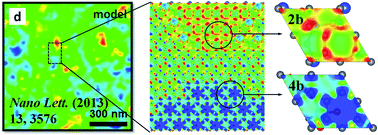Charge inhomogeneity of graphene on SiO2: dispersion-corrected density functional theory study on the effect of reactive surface sites
Abstract
Graphene is a promising high-mobility material, but the mobility of graphene supported on a substrate is far from the theoretical limit. The degradation of remarkable electronic properties is often attributed to a spatial charge inhomogeneity, so-called charge puddle, present in supported graphenes. Since the most widely used substrate for electronic devices, amorphous SiO2, tends to expose various types of surface species, we investigate how a variety of surface species present on amorphous SiO2 substrates would affect the electronic structure of graphenes on them. Four representative surface species (saturated and unsaturated) are constructed on pristine SiO2 (001) surfaces, and a dispersion-corrected spin-polarized density functional theory calculation is carried out on a graphene sheet bound on each of them. The calculation shows that, among the four model species, the unsaturated model with exposed oxygen dangling bonds is the only surface species which can bind graphene rather strongly. Only this one accepts a significant amount of electrons from graphene, leading to a non-negligible amount of p-doping and band-gap opening of graphene. Such reactive surface species present in a mixture with inert ones could be one likely origin of the charge puddle observed in supported graphenes. A thermal annealing or passivation of oxygen dangling bonds on SiO2 would reduce the charge puddle in supported graphenes.


 Please wait while we load your content...
Please wait while we load your content...